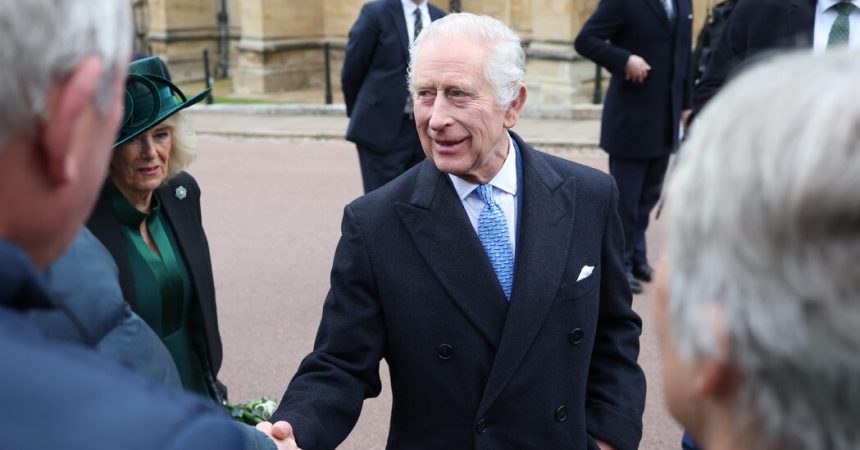King Charles III will return to public duties next week, Buckingham Palace announced on Friday, an encouraging sign of his recovery, nearly three months after he disclosed that he had cancer, and a palpable relief to a country anxious about another wrenching change in the British monarchy.
Charles and his wife, Queen Camilla, will mark his return with a visit to a cancer center on Tuesday, where they will meet with patients and staff, the palace said. He will appear at other engagements later, not least welcoming Emperor Naruhito of Japan, and his wife, Empress Masako, for a state visit in June.
The palace did not offer specific updates on Charles’ medical treatment, condition, or prognosis, in keeping with its policy of sharing some — but not all — details about his illness. Yet in the opaque world of the royal family, the busyness of a monarch’s calendar is often the best clue to his well-being.
The news offers a ray of hope for a royal family that has been shadowed by health concerns since the beginning of the year. Catherine, the Princess of Wales, confirmed last month that she, too, has cancer. She has been out of the public eye since she was hospitalized in January, igniting a storm of often spurious rumors about her condition.
The simultaneous illnesses of two of the royal family’s most senior and stalwart members plunged the House of Windsor into uncertainty at a time of generational transition. Queen Elizabeth II died in September 2022, and Charles, her son, had scarcely gotten his feet under the throne.
Charles, 75, has continued to hold meetings during his treatment, including weekly sessions with Prime Minister Rishi Sunak and a video call with Prime Minister Justin Trudeau of Canada. But his absence has put a strain on other members of the family, particularly Camilla, who has stood in for him on several occasions, including a trip to Northern Ireland. Catherine’s husband, Prince William, has only recently returned to work, after taking time off to care for his wife.
The king first re-emerged in public on Easter Sunday, when he greeted well-wishers after a church service at Windsor Castle. British newspapers have reported that Charles was restless and eager to return to public engagements, including a state visit to Australia, New Zealand, and Samoa scheduled for the fall.
Except for these cryptic reports about his mood, however, the king’s health has been kept under wraps since the palace announced on Feb. 4 that he had an undisclosed form of cancer. Doctors detected it during a procedure to treat an enlarged prostate (the palace clarified that he did not have prostate cancer).
On Friday, the palace said Charles’ cancer treatment would continue, “but doctors are sufficiently pleased with the progress made so far that the king is now able to resume a number of public-facing duties.” His doctors, it said, “remain positive about the king’s continued recovery.”
The paucity of details about the king’s illness has fanned chronic low-level speculation, which has occasionally flared up. Last month, social media channels in Russia reported that Charles had died, citing a phony news release. The British Embassy in Moscow felt obliged to issue a denial.
Beyond the ribbon cuttings, knighting ceremonies, and hospital dedications that absorb much of a monarch’s time, royal watchers said they hoped Charles would pick up what had been the early signs of a campaign to update the monarchy after his mother’s 70-year reign. He had streamlined the number of working royals and was speaking out on issues like climate change and religious pluralism.
“His illness has raised questions over his longevity and whether he will be a transitional or transformational monarch,” said Ed Owens, a historian who writes about the royal family. “I hope for the latter. Now is the time to seize the moment.”
In its statement Friday, the palace said Charles and Camilla were looking forward to the first anniversary of their coronation in May, and “remain deeply grateful for the many kindnesses and good wishes they have received.”
How quickly, or even if, Charles can return to full strength is an open question. But for a family whose recent presence in British life has been mainly through distressing medical bulletins, his re-emergence could augur the return of a more traditional kind of royal news coverage.
There was a hint of that after Meghan, the wife of Prince Harry, introduced a new strawberry jam as part of her lifestyle brand, American Riviera Orchard, and then found herself in a long-distance contest with Buckingham Palace.
After Meghan sent jars of her jam to celebrity social-media influencers, earning favorable reviews, the palace’s shop this week posted a video on its Instagram account of four ways to enjoy its strawberry jam. There was no word on whether the palace’s promotion was a coincidence or an effort to throw shade at Meghan, though the Daily Telegraph swiftly called the episode “Jam Wars.”
After a winter of hospital vigils and ominous speculation, a springtime spat over jam seemed like a welcome return to normalcy.






